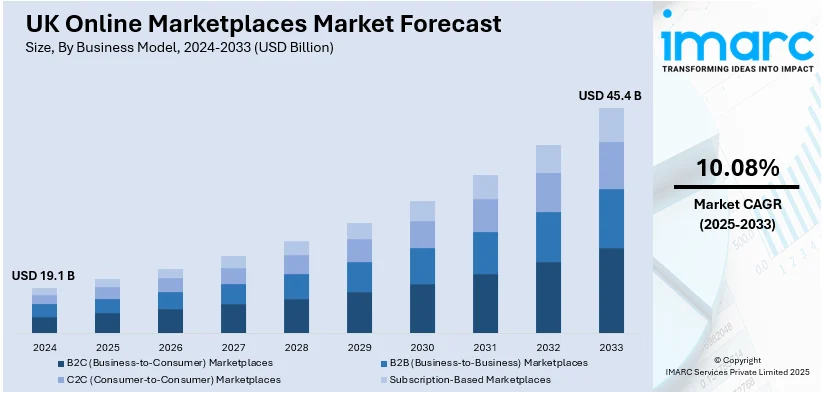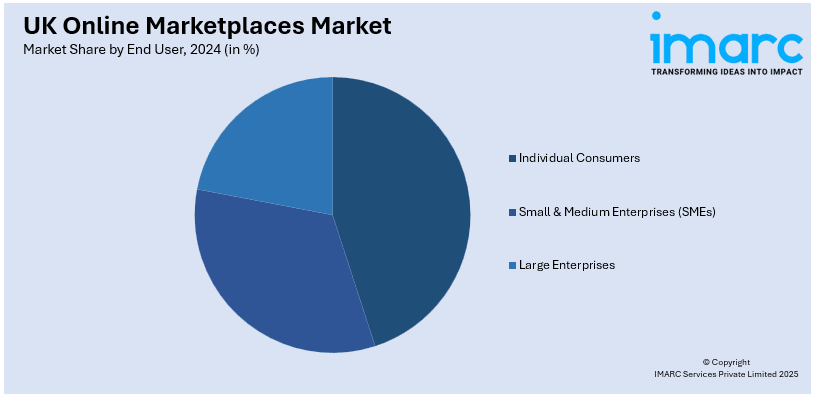
UK Online Marketplaces Market Size, Share, Trends and Forecast by Business Model, Product, Payment Mode, Platform Type, End User, and Region, 2025-2033
UK Online Marketplaces Market Overview:
The UK online marketplaces market size reached USD 19.1 Billion in 2024. Looking forward, IMARC Group expects the market to reach USD 45.4 Billion by 2033, exhibiting a growth rate (CAGR) of 10.08% during 2025-2033. The market is led by the rise in mobile commerce, rising demand for sustainable and second-hand products, the adoption of innovative payment solutions, and the popularity of social commerce platforms.
|
Report Attribute
|
Key Statistics
|
|---|---|
|
Base Year
|
2024
|
|
Forecast Years
|
2025-2033
|
|
Historical Years
|
2019-2024
|
| Market Size in 2024 | USD 19.1 Billion |
| Market Forecast in 2033 | USD 45.4 Billion |
| Market Growth Rate 2025-2033 | 10.08% |
UK Online Marketplaces Market Trends:
Rise of Sustainable Shopping
One of the most notable trends in UK online marketplaces is the growing emphasis on sustainability. Consumers are increasingly prioritizing eco-friendly products and ethical practices when making purchasing decisions. As per Boston Consulting Group, 8% of UK customers are willing to pay extra for sustainable products and services, with many feeling that businesses and governments should support the changes. Besides, up to 70% of consumers are interested in what brands are doing on sustainability. Online marketplaces are responding by curating collections that highlight sustainable brands and products, including those that utilize recycled materials or follow fair trade principles. Most platforms now are integrating features through which shoppers can filter based on carbon footprint or packaging waste. Online marketplaces also aggressively promote goods that are either second-hand or refurbished, seizing the growing tide of the circular economy. This trend attracts environmentally conscious consumers and nudges brands to shift their strategies toward more sustainable production and supply chain management. This leads to the online marketplace as a decisive campaign site for advocacy for sustainability and conscious consumption.

Personalization and Enhanced Customer Experience
The increasing use of customization to enhance the consumer experience is another notable development among UK online marketplaces. Platforms can offer tailored suggestions based on users' search and purchase histories thanks to creative algorithms and data analysis. Such a high degree of personalization aids in providing a more interactive shopping experience, as customers are shown products that are relevant to their likes and dislikes. Additionally, a lot of marketplaces are spending money on machine learning (ML) and artificial intelligence (AI) technology to improve chatbot customer support and search capabilities. This provides real-time support, streamlining the shopping experience. Some platforms are also using social commerce by making use of user-generated content and social media interactions, creating a sense of community among shoppers. As personalization technology advances, UK online marketplaces are increasing customer loyalty and satisfaction, in turn creating more sales and repeat business.
Integration of Augmented Reality (AR)
The integration of augmented reality (AR) is emerging as a transformative trend in UK online marketplaces. By allowing customers to visualize products in their own environment before purchasing, AR enhances the online shopping experience significantly. For instance, furniture stores apply AR technology to allow customers who shop on their homes, by viewing how any article would fit on their premises via their mobile device. Such feature decreases the return rates, and the shopper is assured of their decision to buy the item in question. Fashion stores try some AR applications which provide users with the opportunity to try clothes or accessories virtually in order to make the shopping experience more exciting to the user. The advance of this technology will ensure that it spreads throughout online marketplaces, allowing the consumer experience to bridge the gap between the physical touch feel and the convenience of online retail. This will help to create engagement and sales growth in the industry while changing the way through which people interact with products in the virtual space.
UK Online Marketplaces Market Segmentation:
IMARC Group provides an analysis of the key trends in each segment of the market, along with forecasts at the region level for 2025-2033. Our report has categorized the market based on business model, product, payment mode, platform type, and end user.
Business Model Insights:
- B2C (Business-to-Consumer) Marketplaces
- B2B (Business-to-Business) Marketplaces
- C2C (Consumer-to-Consumer) Marketplaces
- Subscription-Based Marketplaces
The report has provided a detailed breakup and analysis of the market based on the business model. This includes B2C (business-to-consumer) marketplaces, B2B (business-to-business) marketplaces, C2C (consumer-to-consumer) marketplaces, and subscription-based marketplaces.
Product Insights:
- Electronics & Appliances
- Fashion & Apparel
- Home & Furniture
- Groceries & FMCG
- Automotive Parts & Accessories
- Books & Stationery
- Health & Wellness
- Others
A detailed breakup and analysis of the market based on the product have also been provided in the report. This includes electronics & appliances, fashion & apparel, home & furniture, groceries & FMCG, automotive parts & accessories, books & stationery, health & wellness, and others.
Payment Mode Insights:
- Credit/Debit Cards
- Digital Wallets
- Buy Now, Pay Later (BNPL)
- Cryptocurrency Payments
- Others
The report has provided a detailed breakup and analysis of the market based on the payment mode. This includes credit/debit cards, digital wallets, buy now, pay later (BNPL), cryptocurrency payment, and others.
Platform Type Insights:
- Website-Based Marketplaces
- Mobile App-Based Marketplaces
- Omnichannel Marketplaces
A detailed breakup and analysis of the market based on the platform type have also been provided in the report. This includes website-based marketplaces, mobile app-based marketplaces, and omnichannel marketplaces.
End User Insights:

- Individual Consumers
- Small & Medium Enterprises (SMEs)
- Large Enterprises
The report has provided a detailed breakup and analysis of the market based on the end user. This includes individual consumers, small & medium enterprises (SMEs), and large enterprises.
Regional Insights:
- London
- South East
- North West
- East of England
- South West
- Scotland
- West Midlands
- Yorkshire and The Humber
- East Midlands
- Others
The report has also provided a comprehensive analysis of all the major regional markets, which include London, South East, North West, East of England, South West, Scotland, West Midlands, Yorkshire and The Humber, East Midlands, and Others.
Competitive Landscape:
The market research report has also provided a comprehensive analysis of the competitive landscape. Competitive analysis such as market structure, key player positioning, top winning strategies, competitive dashboard, and company evaluation quadrant has been covered in the report. Also, detailed profiles of all major companies have been provided.
UK Online Marketplaces Market News:
- In May 2024, HSS Hire launched the ProService Marketplace, the UK’s largest online building services platform. Offering over 900 sellers and 50,000 active products, the platform allows businesses to buy and hire equipment, materials, and fuel. Key features include emissions tracking, Scope 3 reporting, greener alternatives, and real-time spend visibility. It also enables user access control, automatic digital paper trails, and commercial insights dashboards for improved project management.
- In October 2023, Amazon announced it will use drones to deliver parcels in the UK in under an hour. The massive online retailer stated that the service would launch at an undisclosed site before the end of 2024.
UK Online Marketplaces Market Report Coverage:
| Report Features | Details |
|---|---|
| Base Year of the Analysis | 2024 |
| Historical Period | 2019-2024 |
| Forecast Period | 2025-2033 |
| Units | Billion USD |
| Scope of the Report |
Exploration of Historical Trends and Market Outlook, Industry Catalysts and Challenges, Segment-Wise Historical and Future Market Assessment:
|
| Business Models Covered | B2C (Business-to-Consumer) Marketplaces, B2B (Business-to-Business) Marketplaces, C2C (Consumer-to-Consumer) Marketplaces, and Subscription-Based Marketplaces |
| Products Covered | Electronics & Appliances, Fashion & Apparel, Home & Furniture, Groceries & FMCG, Automotive Parts & Accessories, Books & Stationery, Health & Wellness, Others |
| Payment Modes Covered | Credit/Debit Cards, Digital Wallets, Buy Now, Pay Later (BNPL), Cryptocurrency Payment, Others |
| Platform Types Covered | Website-Based Marketplaces, Mobile App-Based Marketplaces, Omnichannel Marketplaces |
| End Users Covered | Individual Consumers, Small & Medium Enterprises (SMEs), Large Enterprises |
| Regions Covered | London, South East, North West, East of England, South West, Scotland, West Midlands, Yorkshire and The Humber, East Midlands, Others |
| Customization Scope | 10% Free Customization |
| Post-Sale Analyst Support | 10-12 Weeks |
| Delivery Format | PDF and Excel through Email (We can also provide the editable version of the report in PPT/Word format on special request) |
Key Questions Answered in This Report:
- How has the UK online marketplaces market performed so far and how will it perform in the coming years?
- What is the breakup of the UK online marketplaces market on the basis of business model?
- What is the breakup of the UK online marketplaces market on the basis of product?
- What is the breakup of the UK online marketplaces market on the basis of payment mode?
- What is the breakup of the UK online marketplaces market on the basis of platform type?
- What is the breakup of the UK online marketplaces market on the basis of end user?
- What is the breakup of the UK online marketplaces market on the basis of region?
- What are the various stages in the value chain of the UK online marketplaces market?
- What are the key driving factors and challenges in the UK online marketplaces?
- What is the structure of the UK online marketplaces market and who are the key players?
- What is the degree of competition in the UK online marketplaces market?
Key Benefits for Stakeholders:
- IMARC’s industry report offers a comprehensive quantitative analysis of various market segments, historical and current market trends, market forecasts, and dynamics of the UK online marketplaces market from 2019-2033.
- The research report provides the latest information on the market drivers, challenges, and opportunities in the UK online marketplaces market.
- Porter's five forces analysis assist stakeholders in assessing the impact of new entrants, competitive rivalry, supplier power, buyer power, and the threat of substitution. It helps stakeholders to analyze the level of competition within the UK online marketplaces industry and its attractiveness.
- Competitive landscape allows stakeholders to understand their competitive environment and provides an insight into the current positions of key players in the market.
Need more help?
- Speak to our experienced analysts for insights on the current market scenarios.
- Include additional segments and countries to customize the report as per your requirement.
- Gain an unparalleled competitive advantage in your domain by understanding how to utilize the report and positively impacting your operations and revenue.
- For further assistance, please connect with our analysts.
 Inquire Before Buying
Inquire Before Buying
 Speak to an Analyst
Speak to an Analyst
 Request Brochure
Request Brochure
 Request Customization
Request Customization




.webp)




.webp)












